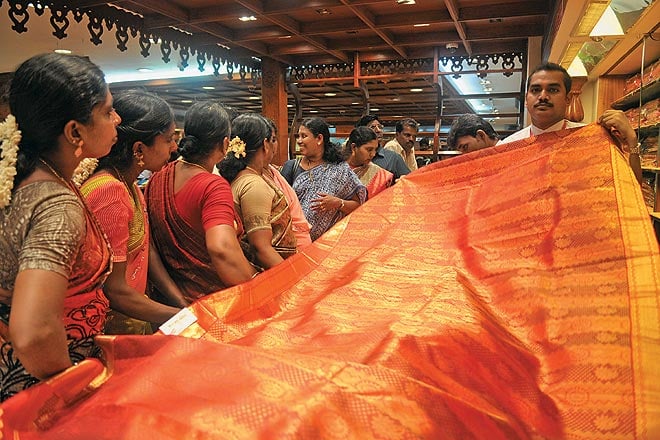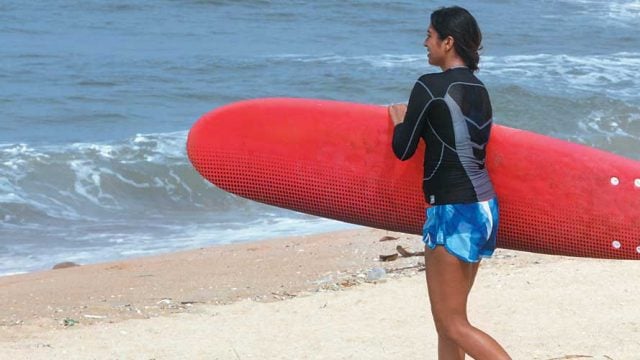The old (‘pazhaya’ to locals, for they have so many branches now) Nalli Chinnasami Chetty is
Chennai’s T Nagar is a thick congregation of several such stores, none of them as charmingly heritage art deco as pazhaya Nalli, but their wares no less dazzling. The world’s best bazaar for a Kanjeevaram pattu is a pretty straightforward place. They’ll tell you up front, printed on the label if you please, whether the silk is the genuine article or ‘mixed’, and if the zari is ‘German’, ‘tested’, ‘half fine’ or simply ‘pure’. The GI (Geographical Indication) certification requires a Kanjeevaram sari to have zari with 57% silver and 0.6% gold. A mid-range sari can have up to 1 marc (19,200m or 242gm) of zari, which alone would cost about Rs 17,000. Prices begin around Rs 4,000 and can go up to Rs 2,00,000. RmKv (rmkv.com), The Chennai Silks (thechen naisilks.com), Pothy’s (pothys.com), Kumaran (kumaransilksonline.com) and Sundari (sundarisilks.com) are some of the big names that rule here.
The competition is intense so they try to outdo each other with, um, ambivalent results — Chennai Silks made it to the Guinness Book of World Records for its Rs 40 lakh ‘vivaha pattu’ studded with navaratna gems and weighing eight kilos; they even bagged a second order from an anonymous buyer. A tag may tell you the number of crystals (15,000, for example) embedded in a ‘designer’ Kanjeevaram at Nalli; Sundari is liked for its ‘different’ approach to both vintage and contemporary patterns, aesthetically achieved by broadening the palette of colours and motifs; Rasi Silks (rasisilks.com) dares to stand alone in Mylapore and has succeeded splendidly for 114 years; Kanakavalli goes one step ahead, retailing through the luxury online portal Parisera (parisera.com/kanakavalli) or by appointment from [email protected].
I have always thought a Kanjeevaram becomes what you want it to be. There are heavier silks with no zari, loved for their elegant wearability, and ‘Kalakshetra borders’ inspired by temple spires and first conceived by Rukmini Devi Arundale at her workshop. There’s the sublime poetry of Tamil colours — eera manjal or freshly uprooted damp turmeric, maanthulir or the fragile amber of just-sprouted mango leaves, paasi payiru or the skin of green moong dal, paaku or the deep brown of betel nuts, sandanam or sandal wood, maambazham or ripe mangoes. There’s butta work that places symmetric dots into the ‘body’ of the sari and there are ‘double colours’ where the warp and weft interplay in clever juxtapositions. There are timeless patterns from nature like the rudraksham seed, sinuous flowering vines, screwpine leaves, swans, peacocks and lotuses, or the annapakshi and yaazhi from mythology. There’s the prized technique of korvai, a tricky three-shuttle weave with an interlocking weft, which has almost seamlessly attached borders and thalaipus (pallus) in contrasting colours, achieved by a process called ‘petni’ that requires two weavers to work simultaneously on a sari. There are ‘full gold’ brocades, and ‘tissue’ weaves which use zari and silk equally so that the sari literally glows and its tassles end as tied threads of gold. And there’s my favourite, the vaira oosi or ‘diamond needle’, which features a diamond-patterned border and muted needles of zari running past rich silk, preferably in a deep shade of yennai (‘oil’) arakku, a rosewoody tint with the sort of sheen that has no match in English when it adorns a Kanjeevaram. It’s difficult not to succumb. Best of all, you don’t even need the most expensive Kanjeevaram to feel wonderfully rich.
Kanjeevaram silks
Silk saris
Tamil Nadu
Leave a Reply
You must be logged in to post a comment.





